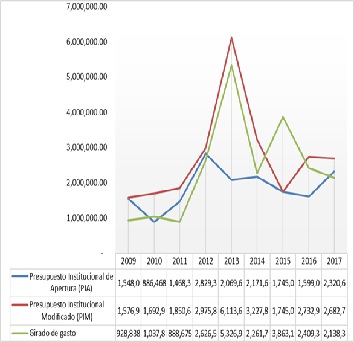Execution of tourism expenditure and its impact on the economic development (GDP) of the San Martín region between 2009 and 2017
DOI:
https://doi.org/10.56926/unaaaciencia.v4i1.119Keywords:
budget analysis, regional growth, fiscal performance, public investment, productive sectorsAbstract
The research aimed to determine the impact of tourism expenditures on economic growth (GDP) in the San Martín Region between 2009 and 2017. The study was comparative and descriptive, with a sample comprised of nine analysis periods. A documentary analysis guide was used for data collection. The results revealed that, in the initial periods, tourism expenditures were below the Institutional Opening Budget (PIA); however, from 2012 to 2016, a balance was observed, with amounts allocated ranging from S/. 2,409,386.00 as the minimum and maximum. Regarding economic growth, a positive trend was identified, starting from the first period with a total of S/. 3,740,600.00, reflecting a sustained increase driven by activities such as agriculture, livestock, hunting and forestry, manufacturing, commerce, public administration, lodging, and restaurants. Through the application of Pearson's statistical test, it was concluded that the impact of tourism expenditure on the GDP of the San Martín Region was neither significant nor positive, indicating the influence of other factors on said growth.
Downloads
References
Aparicio Acurio, M., & Duran Cárdenas, D. L. (2012). Análisis de la gestión de riesgos de un proyecto de inversión pública en turismo de sol y playa durante su fase de inversión: el caso del proyecto acondicionamiento turístico de la playa de centro Máncora [Universidad Nacional de Ingeniería]. http://hdl.handle.net/20.500.14076/1404
Bernal, F. (2008). Actualidad empresarial: La ejecución presupuestaria (1.a ed.). Editorial Legis.
CANATUR. (2011). Turismo contribuye hasta con 7% del PBI del Perú. Cámara Nacional de Turismo. ANDINA. https://andina.pe/agencia/noticia.aspx?id=385272
Castro-Buitrago, E., Restrepo-Yepes, O. C., & García-Matamoros, L. V. (2011). Historia, concepto y estructura de los derechos económicos sociales y culturales. Estudios Socio-Jurídicos, 9(Especial), 77-108. https://revistas.urosario.edu.co/index.php/sociojuridicos/article/view/457/399
Coello, A. (2015). Producto Bruto Interno: PBI (Parte I) (1.a ed.). Actualidad Empresarial. http://aempresarial.com/web/revitem/2_17510_86651.pdf
Diaz Santivañez, J. S. (2016). Evaluacion del impacto del turismo rural comunitario en el desarrollo socioeconómico del Distrito de Sibayo – Caylloma, 2015 [Universidad Nacional de San Agustín]. http://repositorio.unsa.edu.pe/handle/UNSA/3660
Espinoza H., A. (2023). Economía circular: una aproximación a su origen, evolución e importancia como modelo de desarrollo sostenible. Revista de Economía Institucional, 25(49), 109–134. https://doi.org/https://orcid.org/0000-0003-1258-6056 DOI: https://doi.org/10.18601/01245996.v25n49.06
Gonzáles, J. (2017). El turismo genera un récord de 15.573 millones y más de 326.000 empleos en Canarias en 2017. 20 minutos. https://www.20minutos.es/noticia/3393494/0/turismo-genera-record-15-573-millones-mas-326-000-empleos-canarias-2017/
Hernández Sampieri, R., Fernández collado, C., & Baptista Lucio, M. D. (2014). Metodología de la Investigación (6.a ed.). McGRAW-HILL / INTERAMERICANA EDITORES, S.A.
INEI. (2007). Producto bruto interno : Región San Martín. Instituto Nacional de Estadística e Informática. https://biblioteca.bcrp.gob.pe/discovery/fulldisplay?docid=alma991000052319709006&context=L&vid=51BCDRDP_INST:51BCDRDP2&lang=es&adaptor=Local Search Engine&tab=Everything&query=sub,equals,Cuentas Regionales,AND&mode=advanced&offset=0
Lambogglia Ortíz, J. C. (2014). Análisis del turismo y su importancia en el crecimiento económico en América Latina: el caso del Ecuador. [Biblioteca Digital de Vanguardia para la Investigación en Ciencias Sociales REGIÓN ANDINA Y AMÉRICA LATINA]. http://hdl.handle.net/10469/7460
Lopez Garcia, K. M., Paredes Garcia, A. B., & Valdivia Flores, M. A. (2016). Potencial para el desarrollo del turismo de naturaleza en el distrito de Chazuta-provincia de San Martín - departamento de San Martín - Perú [Universidad Nacional de San Martín]. http://hdl.handle.net/11458/2545
MEF, & DGPI. (2011). Guía Metodológica para la Identificación, Formulación y Evaluación Social de Proyectos de Inversión Pública del Sector Turismo, a Nivel de Perfil (1.a ed.). Ministerio de Economía y Finanzas. Dirección General de Política de Inversiones.
MINCETUR. (2016). Medición económica del turismo (p. 24). Ministerio de Comercio Exterior y Turismo. https://repositorio.promperu.gob.pe/items/c860edeb-35d6-4983-be8b-c851c51a9004
Solórzano Zavala, J. R. (2022). Una visión teórica de la ejecución presupuestaria en el contexto de la gestión por resultados. Ciencia Latina Revista Científica Multidisciplinar, 6(5), 4931-4947. https://doi.org/10.37811/cl_rcm.v6i5.3450 DOI: https://doi.org/10.37811/cl_rcm.v6i5.3450
Soto, C. (2015). El presupuesto público y el Sistema Nacional de Presupuesto. Ministerio de Economía y Finanzas. https://www.mef.gob.pe/es/?option=com_content&language=es-ES&Itemid=100751&view=article&catid=29&id=78&lang=es-ES
Valderrama Pérez, Y., & Paúcar Ccahuana, R. (2015). El sector turismo y su impacto en el crecimiento económico de la región Cusco, durante el periodo 2004-2014 [Universidad Nacional de San Antonio Abad del Cusco]. http://hdl.handle.net/20.500.12918/120
Villanueva Álvaro, J. J. (2017). El turismo como motor de crecimiento económico sostenible el caso especial del turismo rural [Universidad de Castilla-La Mancha]. https://dialnet.unirioja.es/servlet/tesis?codigo=149993

Downloads
Published
How to Cite
Issue
Section
License
Copyright (c) 2025 Magda Ushiñahua-Ushiñahua, khunji Marilyn Alarcón-Jiménez, Aníbal Pinchi-Vásquez, Jerris Rojas-Vela, Roselinda Solano-Reátegui

This work is licensed under a Creative Commons Attribution 4.0 International License.
The authors retain their rights:
a. The authors retain their trademark and patent rights, as well as any process or procedure described in the article.
b. The authors retain the right to share, copy, distribute, execute and publicly communicate the article published in the scientific journal UNAAACIENCIA-PERÚ (for example, place it in an institutional repository or publish it in a book), with an acknowledgment of its initial publication in UNAAACIENCIA-PERU.
c. Authors retain the right to make a subsequent publication of their work, to use the article or any part of it (for example: a compilation of their works, notes for conferences, thesis, or for a book), provided that they indicate the source. of publication (authors of the work, magazine, volume, number and date).







